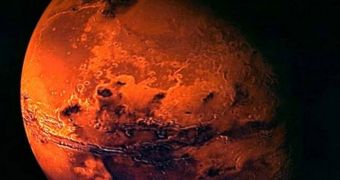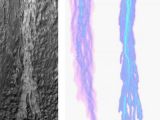Not only that, but the new study published by the University of Arizona refutes the evidence that liquid water ever flowed on the surface of the Red Planet. The evidence? Martian gullies which seem to have been carved by the erosive action of some kind of liquid agent, which were spotted on the Martian surface in 1999. Jod D. Pelletier, the lead author of the study, writes that there is clear evidence to contest the fact that pure water flowed on Mars.
By using images brought back by the Mars Reconnaissance Orbiter back in 2006, which surprised topographic features of the Red Planet in extremely high detail, Pelletier was able to construct physical models of how pure liquid water would flow through such gullies and compare them with the flow of dry granular material. Naturally the results were far from shocking, dry granular material seems to fit the best description of what these structures came to be.
Jod, on the other hand, recognizes to have been rather disappointed of the result, as the main goal of his study was to prove that indeed the Martian gullies were carved by pure liquid water. Secondly, co-author of the paper Alfred S. McEwen says that contrary findings would have pointed towards the best spots to look for evidence of possible past and current life forms on the surface of the Red Planet.
McEwen, which is also the principal investigator and director of UA's Planetary Image Research Laboratory, reveals that computer simulations and calculations predict that the most likely formation process which led to the creation of the gullies involves an avalanche of dry debris flowing under the action of the gravitational force of the Red Planet.
However, the study also reports some good news. It might not have been a pure water flow, albeit a mud-containing water, in concentrations of about 50 percent, would also fall inside the model predicted by the computer simulations. In late 2006, a team of researchers led by Michael Malin released a paper concluding that liquid water might have once flowed on the surface of Mars, as a result of the discovery of two Martian gullies back in 1999. Not only that, by the study seems to suggest that such processes might have taken place rather recently, in the last two decades or so.
Indeed, the Mars Global Surveyor Mars Orbital Camera proved that the structures could have formed in the recent past, and only seven years later the same orbiter seemed to have found evidence of structures that were not present in the previous image, suggesting that the erosive action altered the configuration of the gullies in the respective time interval.
Pelletier became interested in the findings of the MOC instrument and started to construct a stereoscopic computer-generated topographic map of the respective surface features, known as digital elevation models, or DEM's for short. While creating a DEM of a particular gully that presented evidence of bright streaks of material, Jod realized that he could accurately predict whether the particular appearance of the gully can be created by pure water flow or a dry avalanche of material.
It is the first time when a computer simulated model produced the conditions observed with the HiRISE camera, thus proving that other substance except water can form the specific shape of a gully, to successfully contest the idea that pure liquid water ever flowed on the surface of Mars. The team is currently evaluating the possibility of studying similar bright material deposits in less steeper structures, in order to determine through what processes they could have been formed.

 14 DAY TRIAL //
14 DAY TRIAL // 
